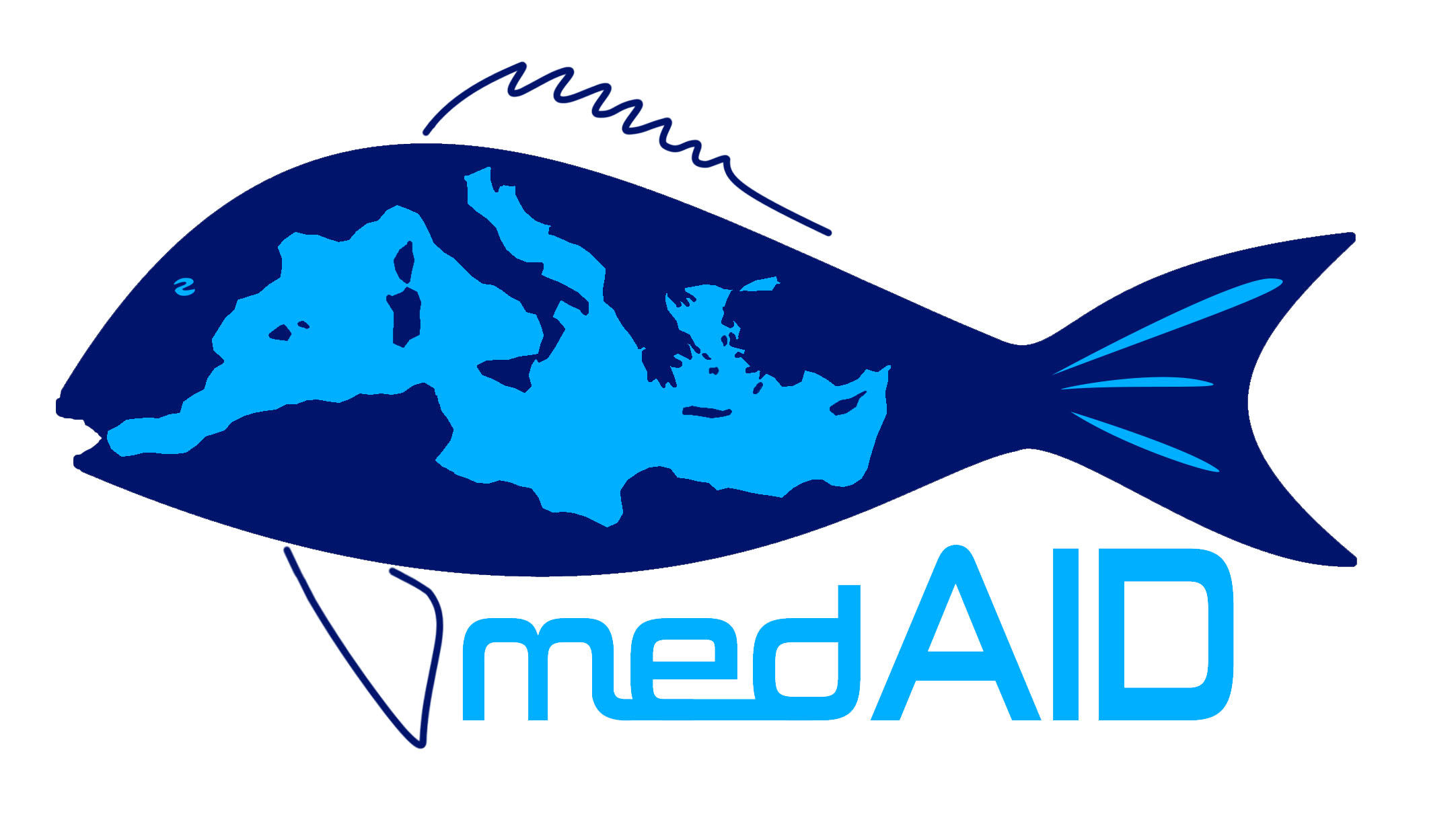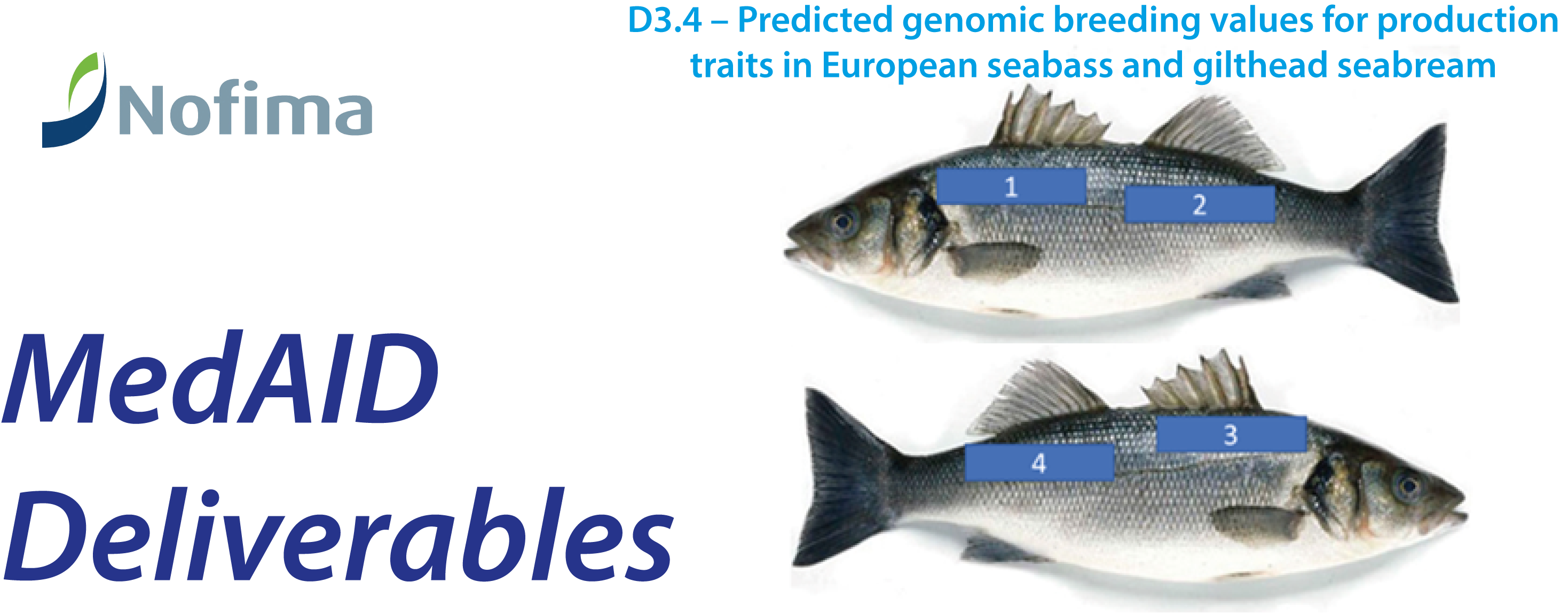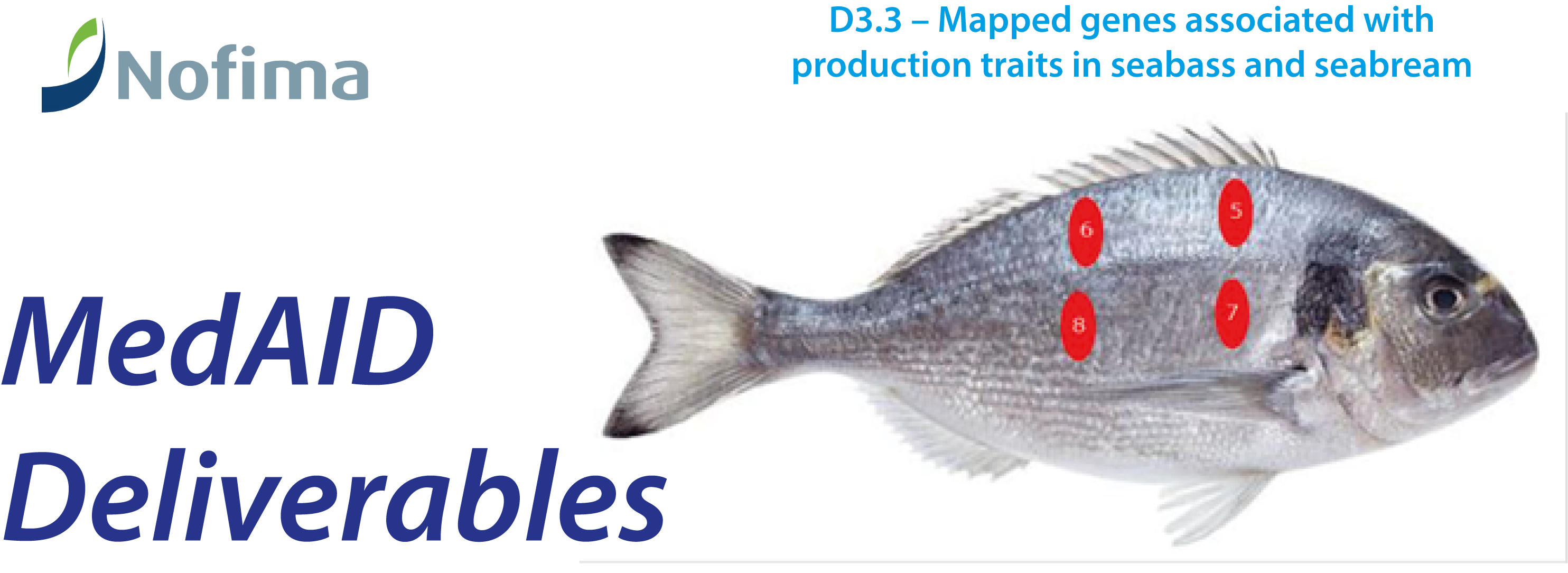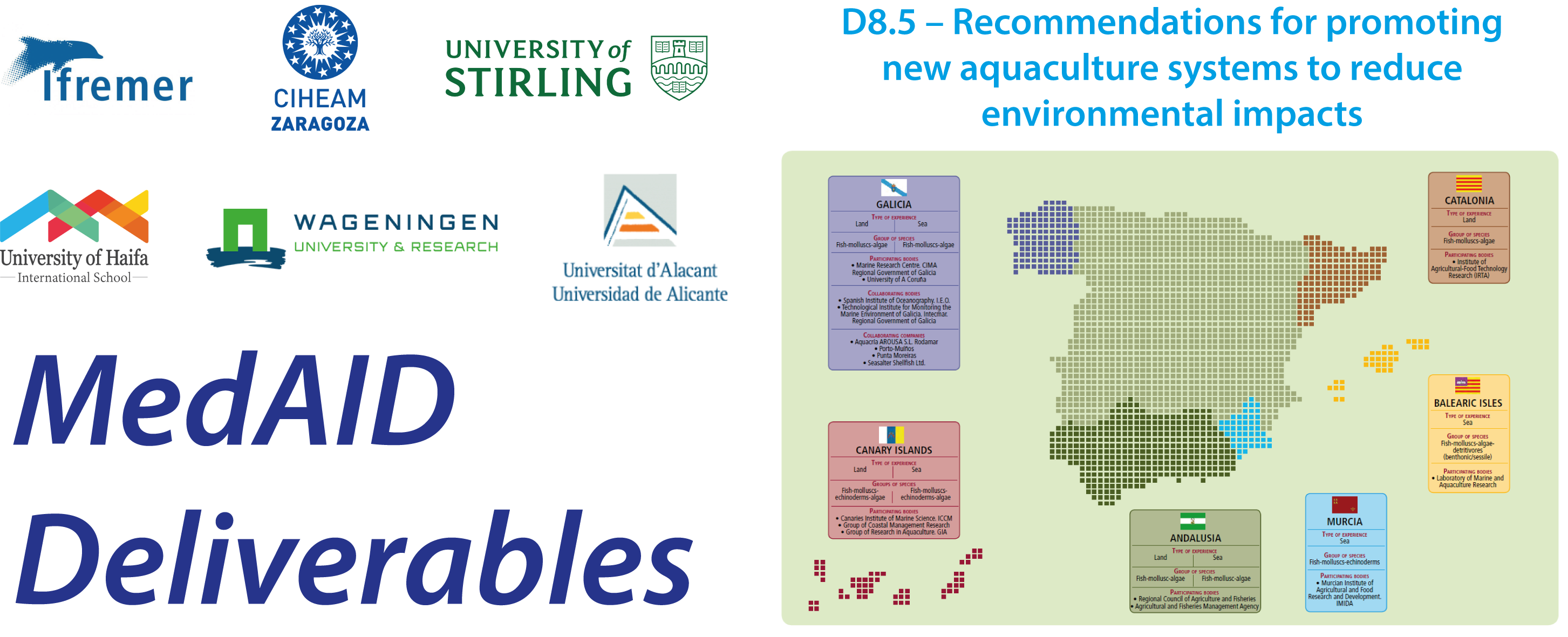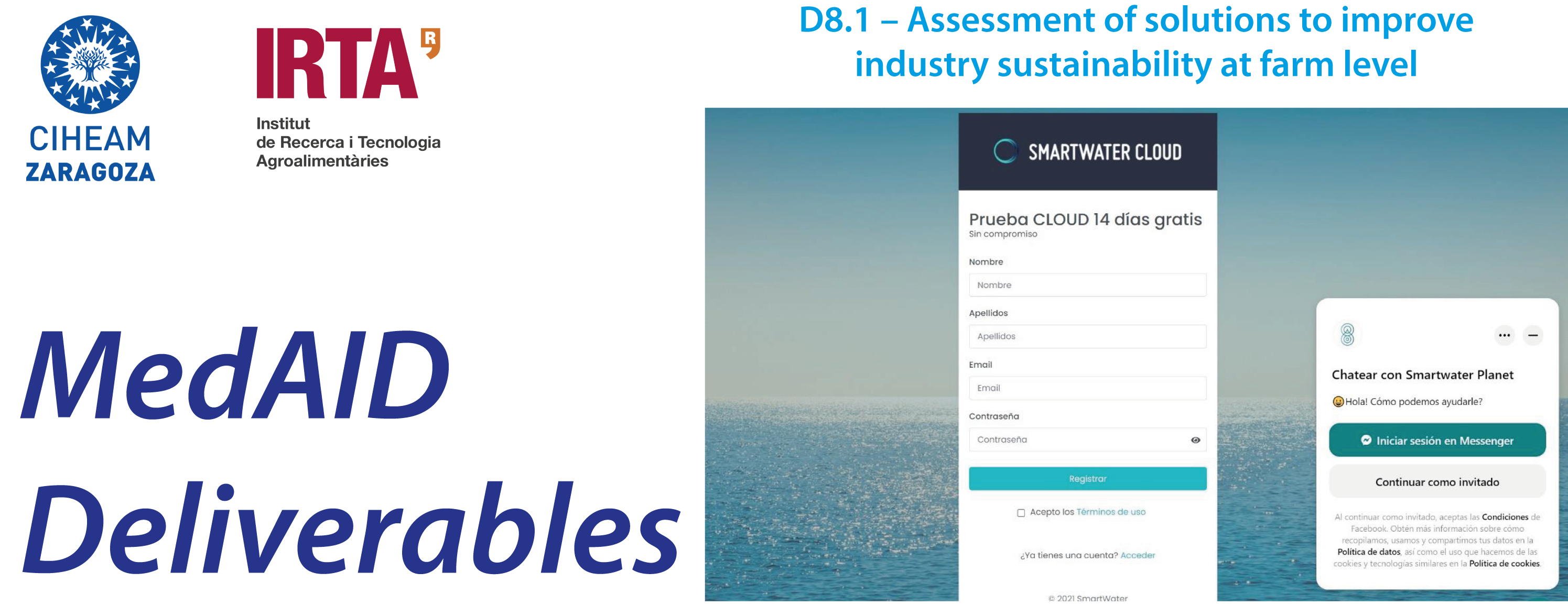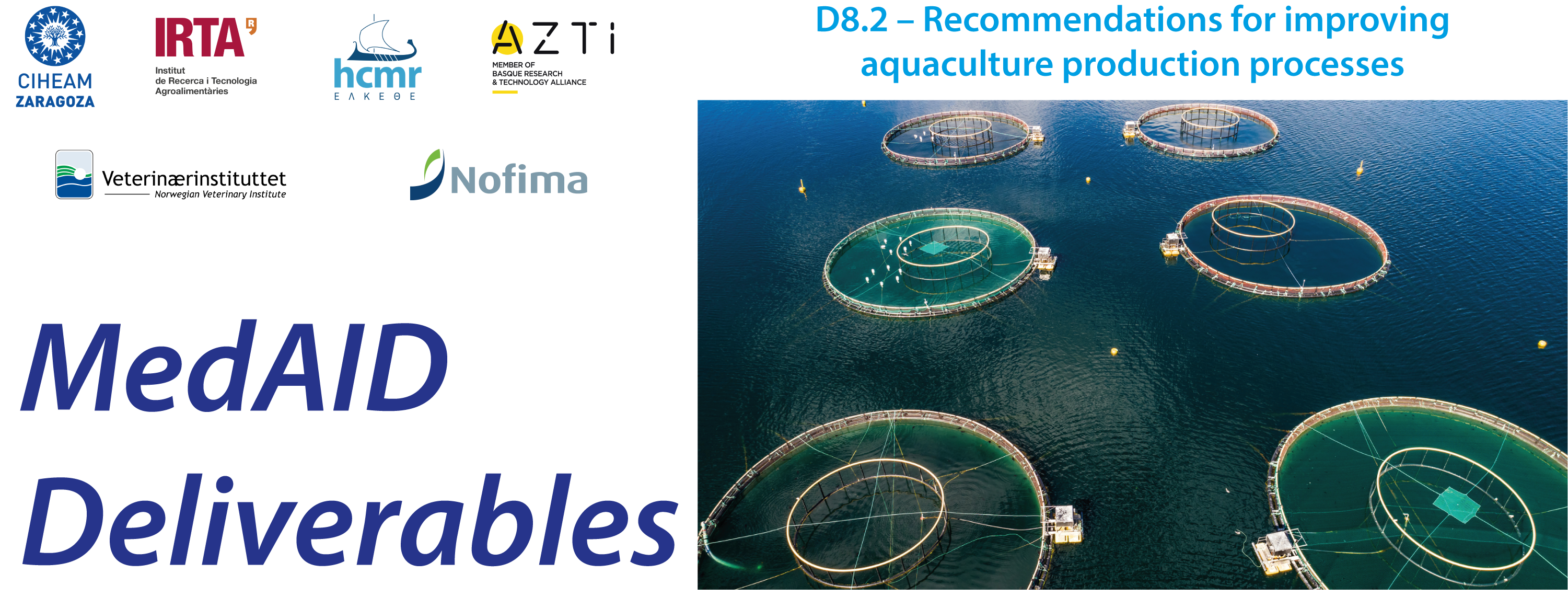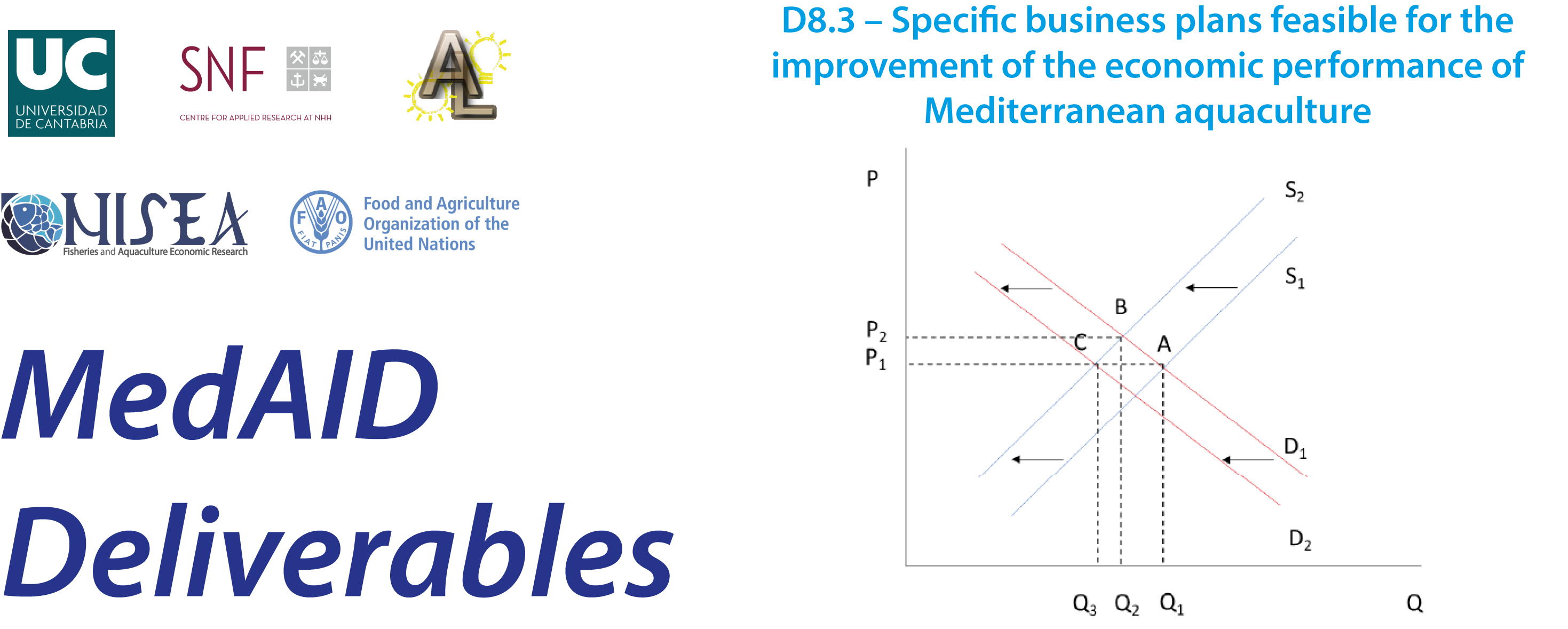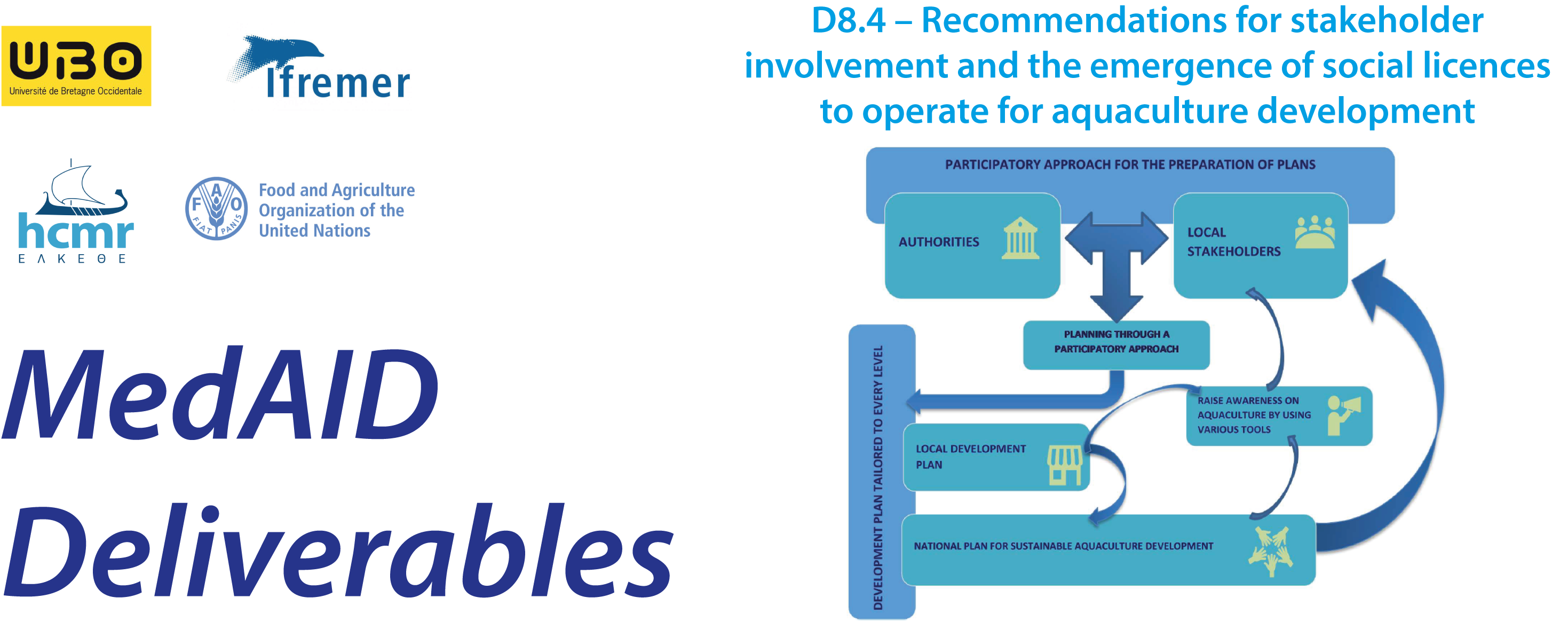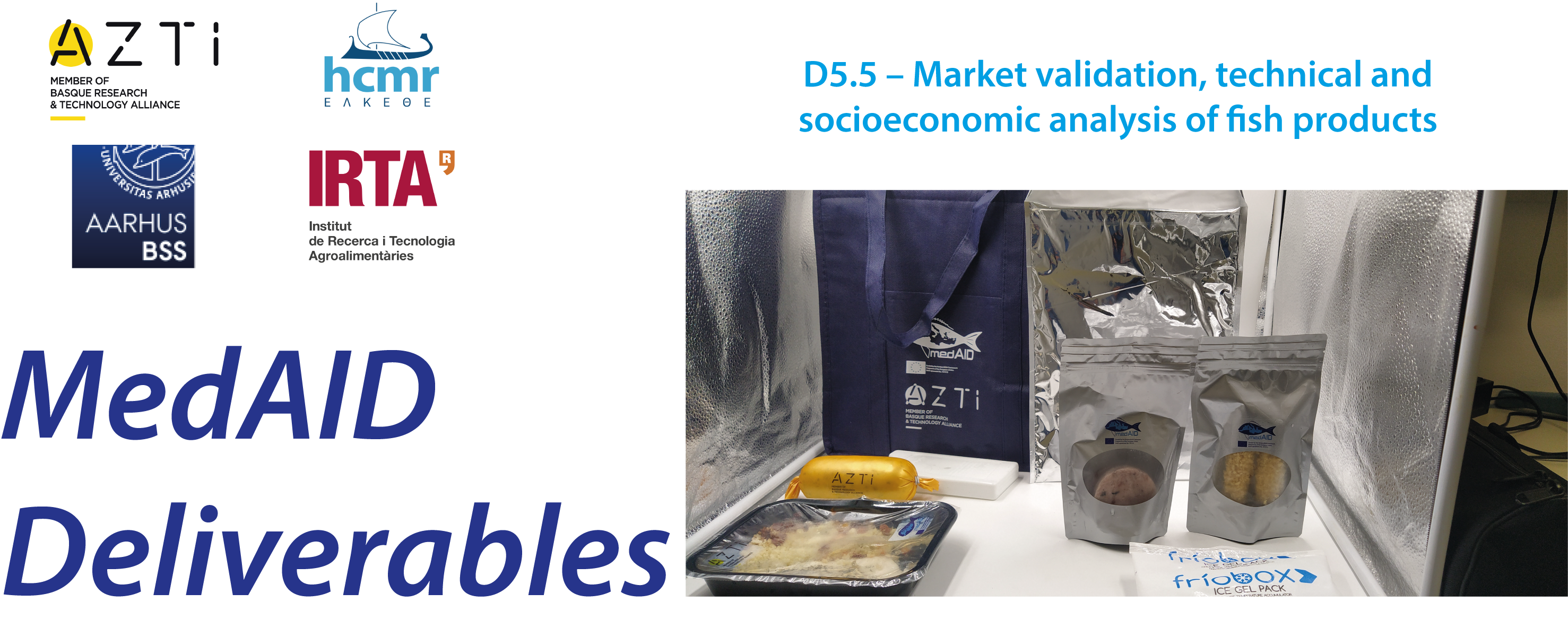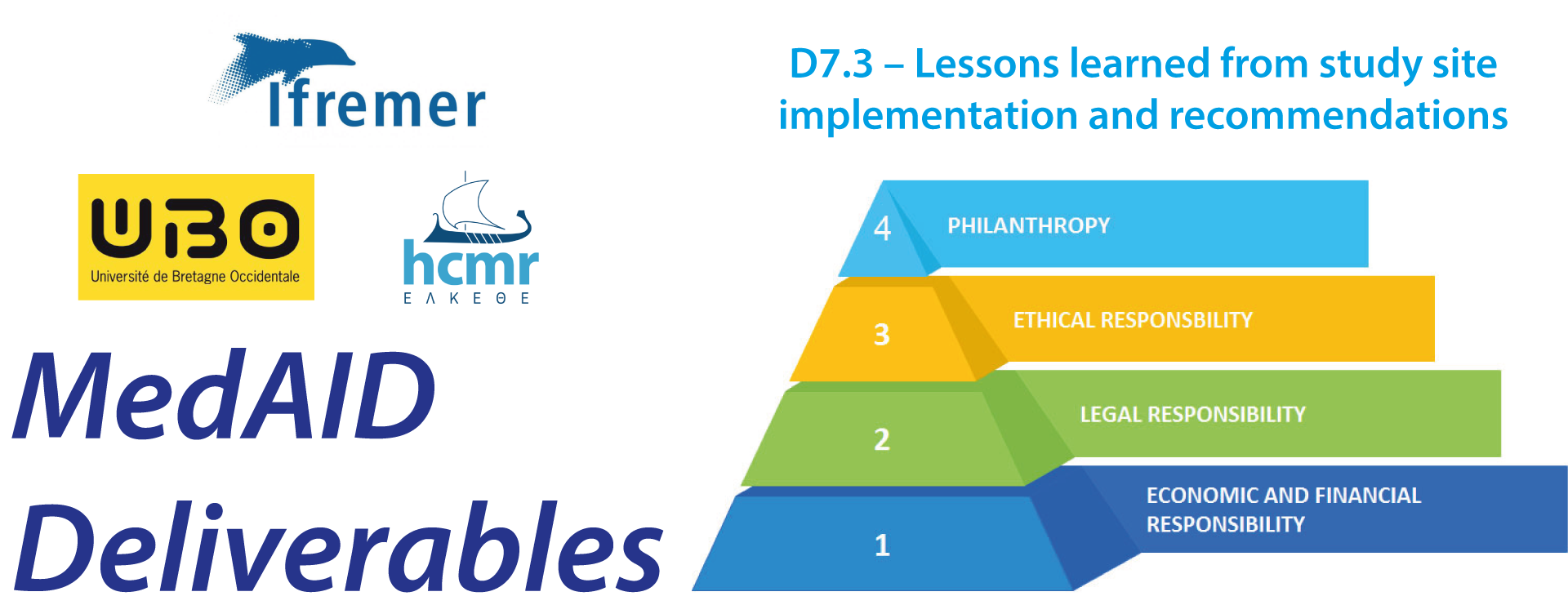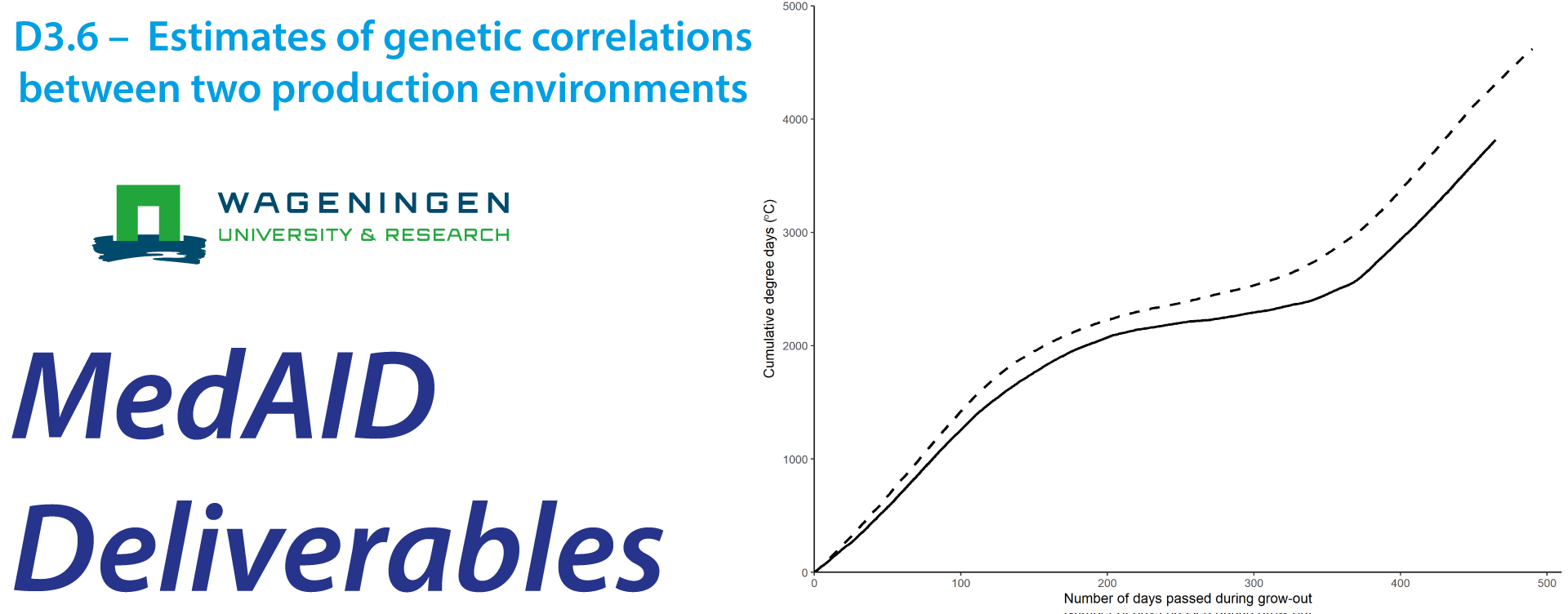Lipids are important in all animal production because they are linked to production efficiency, health and product quality. Excess dietary lipids that are not deposited in the edible muscle or used as energy source for growth are considered a loss and an indicator of low efficiency. In addition, the fatty acid profiles of the fat affect the health of both the fish and the human consumers and both European seabass and gilthead seabream are important sources of omega-3 fatty acids in the Mediterranean diet.
This deliverable must be read together with Deliverable 3.2. Phenotypic and genetic records (Gamsiz et al., 2020), where we presented the phenotypic analysis of the same data sets presented here, in both seabass and seabream. In the current deliverable, we present heritability (calculated as genetic variation divided by total phenotypic variation) and genetic correlations for fatty acids and other lipid-related production traits, as well as genomic predictions for these traits. This provides valuable information for better understanding of the genetic basis of the traits studied and opens for the inclusion of lipid related production traits, including individual omega-3 fatty acids in breeding programmes of seabass and seabream.
Deliverable D3.3 – Mapped genes associated with production traits in seabass and seabream
Lipids are important in all animal production because they are linked to production efficiency, health and product quality. Excess dietary lipids that are not deposited in the edible muscle or used as energy source for growth are considered a loss and an indicator of low efficiency. In addition, the fatty acid profiles of the fat affect the health of both the fish and the human consumers and both European seabass and gilthead seabream are important sources of omega-3 fatty acids in the Mediterranean diet. Two important omega-3 fatty acids are eicosapentaenoic acid (EPA) and docosahexaenoic acid (DHA).
This deliverable must be read together with Deliverable 3.2. Phenotypic and genetic records (Gamsiz et al., 2020), where we presented the phenotypic analysis of the same data as presented here in both seabass and seabream. In the current deliverable we present results from the Genome Wide Association Study, which aims at identifying associations between genetic variants and traits of interest. This can provide valuable information for better understanding of the genetic basis of the traits studied and opens an opportunity to implement genomic selection in the respective breeding programmes. Focus is on lipid-related production traits, including body and muscle fat contents and fatty acid composition of muscle fat.
Continue readingDeliverable D8.5 – Recommendations for promoting new aquaculture systems to reduce environmental impacts
The MedAID project (Mediterranean Aquaculture Integrated Development) aims to increase the competitiveness and sustainability of the Mediterranean marine fish aquaculture sector throughout its value chain, by improving its technical productivity and economic performance with a market- and consumer-oriented approach, as well as achieving higher social and environmental acceptability and better governance (Aguilera et al., 2019). The development of aquaculture will necessarily involve an increase in the spaces devoted to this activity, due to the expansion of existing businesses and/or the creation of new ones. Conflicts pertaining to the use of marine space and the implementation of existing policies and legislation are two of the main factors hindering aquaculture growth (Galparsoro et al., 2020). Marine spatial management must be improved to facilitate site selection processes, alongside the establishment of transparent procedures and licencing processes, thus reducing the length of time and investment needed to develop new aquaculture activities. In addition, the increase in production will generate a proportional increase in the amounts of feed, which are often produced outside the countries concerned. If aquaculture is to double its production by 2030, the sector must improve its productivity, without compromising environmental performance (Lotze et al., 2019). Aquaculture can affect ecosystems (socially, economically and environmentally) positively or negatively, and aquaculture can be impacted by other human activities. Environmental impacts vary greatly depending on the type of farming in question (inland open flow, RAS, cages in protected areas or offshore) and husbandry practices (species, stocking density, feed composition, etc …). Continue reading
Deliverable D8.1 – Assessment of solutions to improve industry sustainability at farm level
MedAID work package 8 (Integrated proposals for an innovative and competitive sector) will bring together outcomes from MedAID WPs to design and propose innovative management practices in order to improve the overall competitiveness and sustainability of the Mediterranean marine aquaculture sector’s whole value chain. It will do so by improving its zootechnical and business performance and by shifting from a production-based approach to a sustainable market-oriented business with a higher social and consumer reputation. This is undertaken based on the preliminary holistic sustainability assessment of the Mediterranean marine fish farming sector (WP1) and on the specific contributions proposed by disciplinary work packages 2 to 7.
This Deliverable reports on the work implemented in Task 8.1 (Task 8.1. Integration of the assessment and proposed solutions at the farm level), and compiles and integrates results and outputs from previous WPs using a multidimensional approach. The database developed in WP1 Task 1.1, based on a survey of Mediterranean aquaculture farms located throughout the region (Deliverables D1.1, D 1.2, D1.3 ), is used as the main element of analysis, providing indicators and keywords to integrate into an ad hoc technology watch platform, developed by IRTA, to analyse all project technical innovations for farming management, nutrition, operational welfare indicators (OWIs), product quality, genetic improvement, health management and other recommendations to apply in the case study trials and with other potential users. Moreover, business, social and institutional aspects are also considered.
Continue readingDeliverable D8.2 – Recommendations for improving aquaculture production processes
Deliverable 8.2 consist of a compilation of the main outputs from MedAID project, regarding its transferability and applicability to all stakeholders of the Mediterranean marine fish farming sector, seabass and seabream, focusing on the assessment of the sector, productive (zootechnics, genetics, health) processes and the development of new products. It is, therefore, a collaborative work, where the 8.2 Task Leader, the Project Coordination Team, all Work package 1 to 5 leaders and related task leaders, worked together to synthetize their research results on sound based conclusions and recommendations.
Conclusions and recommendations from all MedAID work-packages were presented and discussed in seven thematic forums (webinars), followed by closed sessions with invited stakeholders. Thereafter, seven thematic factsheets were produced and distributed in MedAID Final Event held on 5th October during the Aquaculture Europe E2021 Conference held in Madeira. The factsheets, which are already available in the project Toolbox, constitute a key component of the communication and transference outputs of the project.
Continue readingDeliverable D8.3 – Specific business plans feasible for the improvement of the economic performance of Mediterranean aquaculture
This task develops the strategic implications in the form of guidelines for improving market returns, based on the findings of WP 6 tasks. These tasks covered topics related to economics of production, market dynamics, communication and organizational areas. The results from all these tasks enabled the identification of the industry’s internal strengths and weaknesses and external opportunities and threats. The resulting items identified in the previous tasks are described in a SWOT diagram.
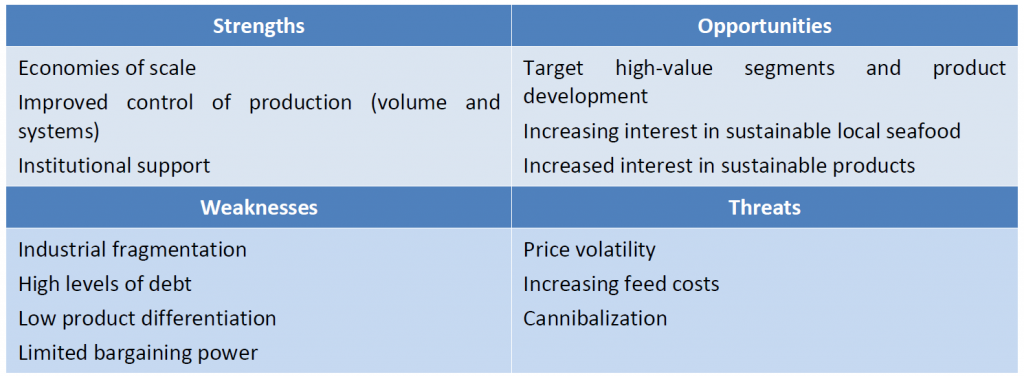
All these results are referred to the dominant economic and market conditions that prevailed when the tasks were implemented. The outbreak of Covid-19 and the following shocks caused by the spread of the pandemic have disrupted both the economy and the markets. The impacts on the business of Mediterranean aquaculture are still ongoing and not clearly assessed. However, the main mid-term trends can be identified. All costs are expected to keep rising. Among these, labour and capital costs affect companies’ productivity. Meanwhile, the costs of raw materials, feed and livestock are also expected to keep on rising, affecting the efficiency of production. All these cost increases will have an impact on the companies’ profitability. Farmers will have to increase their prices in order to sustain the profit levels which enable them to keep on producing fish, repay debts and the investment rents. However, in a market with an elastic demand, a rise in the price will be followed by a contraction in demand, reducing companies’ sales and potentially their incomes. Indebtedness and liquidity will be critical factors in stating whether a company is in position to undertake new strategic developments.
Continue readingDeliverable D8.4 – Recommendations for stakeholder involvement and the emergence of social licences to operate for aquaculture development
Mediterranean marine fish aquaculture is facing a wide range of challenges that threaten its further development, competitiveness and sustainability. The sector has been affected by its low performance and the financial crisis, but also because fish producers operate within a complex regulatory, institutional and social framework. Understanding the social stumbling blocks that lead to the stagnation of sustainable aquaculture development in the Mediterranean Sea is an area of study that has been frequently overlooked.
Beyond the classic approaches of spin-offs or jobs, which more often provide material for communication or promotion of a sector rather than questioning its sustainability, the social dimensions of aquaculture development can also be understood in terms of its wider public dimension. A public dimension that also integrates ecological and economic dimensions. The remaining and pending question about aquaculture development is still the same as it was at the inception of modern marine aquaculture: sustainability and integration to reach this sustainability. Social acceptability as an understanding of the acceptability of aquaculture development within society, and not limited to its solely social dimension, allows us to integrate ecological, economic and social dimensions of aquaculture development to redirect this development onto a more sustainable path. It allows us to put governance at the core of sustainability and address the territorial dimension of aquaculture development by co-constructing a territory’s aquaculture vision before moving into site selection and carrying capacity. If it has to be compared to the traditional approach of aquaculture development based on site selection and carrying capacity, it would be best to take an integrated approach to the carrying capacity concept, an integrated carrying capacity encompassing the ecological carrying capacity, the economic carrying capacity and the social carrying capacity.
Continue readingDeliverable D5.5 – Market validation, technical and socioeconomic analysis of fish products
Innovation and development of new products for existing and new markets is clearly needed for a long-term competitive supply-demand equilibrium of Mediterranean marine aquaculture. As in the rest of the food industry, the improvement of the competitiveness and sustainability of the sector is governed by current consumer trends, which translates into the need to transform aquaculture species to offer consumers the safe, healthy, quality and convenience products they demand.
Considering the current consumer demand and the lack of aquaculture seafood products on the market, the development of new fish aquaculture products can be an opportunity to generate differentiation in the product range and increase the commercial value and profitability of the Mediterranean aquaculture value chain.
Moreover, the changes that the European consumer is experiencing in terms of new lifestyles, trends and habits in food purchasing and consumption, and others such as increasing food environmental awareness, are influencing the development of innovations in the food market regarding new product concepts but also affecting production and market strategies and marketing channels.
Continue readingDeliverable D7.3 – Lessons learned from study site implementation and recommendations
This report details the work carried out under Task 7.3 of WP7 (“Social acceptability and governance”). It mainly analyses how the social acceptability of aquaculture has been addressed with stakeholders in several case studies. More specifically, three case studies were selected to provide a comprehensive view of this issue in different institutional, political, economic and social and cultural contexts. One case study concerns the development of aquaculture in Greece with a focus on several territories, a second concerns the analysis of aquaculture development in the region of Andalusia, Spain, and finally the third case study concerns an analysis of further development of aquaculture in the Bay of Monastir, Tunisia.
In these case studies, the social acceptability of aquaculture was addressed by considering the different dimensions that may condition the perception and attitudes of local communities towards the aquaculture sector and its products. These dimensions are often addressed through the private considerations related to the positive or negative impacts that aquaculture companies can induce on the social ecological systems where they take place. But public considerations must also be taken into account associated to the role played by public authorities in the governance of coastal territories. Policies aiming at aquaculture development in the framework of the blue economy are confronted with the social complexity encountered in integrated management and maritime spatial planning.Continue reading
Deliverable D3.6 – Estimates of genetic correlations between two production environments
Genotype-by-environment (GxE) interaction is the phenomenon that occurs when different genotypes perform differently in different environments. If GxE exists, selection strategies need to be adapted or separate environment-specific breeding programmes need to be developed. Annual temperature regimes vary across the Mediterranean basin. To estimate the GxE, gilthead seabream from the experiment described in Deliverable 2.4 (Estévez et al, 2021) were genotyped and phenotyped at the time of harvest in a real-scale case study, conducted simultaneously in Greece and in Spain. In order to produce comparable data and test the interaction with the environment between sites, apart from the husbandry practice, fish batches, feed and feeding regimes were the same in both sites. Also, sea cages were of the same size (16 m diameter). Low genetic correlations (< 0.7) point to the existence of GxE.
Differences were observed between local environmental conditions, particularly the temperature profile, at the two sites during the growing period. Growth rate (thermal growth coefficient, TGC) and harvest weight were found to have moderate to strong heritabilities in both sites and the same was true for the quality traits of fillet weight and fillet fat percentage. These heritabilities indicate that important improvements can be made with selective breeding in those traits. Harvest weight, growth rate, and fillet weight all showed strong GxE interactions, with genetic correlations below 0.5. This means that breeding for improved production efficiency across a range of environments needs to account for this strong GxE and cannot rely on measurements in a single environment. The GxE observed for fillet fat percentage was very limited (high genetic correlation of 0.9), which indicates that for this specific trait the local environmental conditions have limited effect on the genetic ranking of fish. These estimates are important to allow genetic improvement for production across different environmental conditions of the many sites where gilthead seabream are produced. In addition, the results from this deliverable also indicate the need to breed fish with an improved ability to deal with rapidly changing environmental conditions, i.e. caused by climate change.Continue reading
